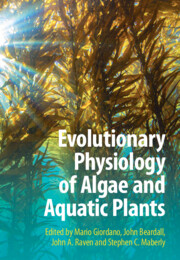Book contents
- Evolutionary Physiology of Algae and Aquatic Plants
- Evolutionary Physiology of Algae and Aquatic Plants
- Copyright page
- Contents
- Contributors
- Preface
- Acknowledgments
- 1 Environmental Changes Impacting on, and Caused by, the Evolution of Photosynthetic Organisms
- Part I Origins and Consequences of Early Photosynthetic Organisms
- Part II Physiology of Photosynthetic Autotrophs in Present-Day Environments
- 7 Light as a Major Driver of Algal Physiology and Evolution
- 8 Temperature: Still an Enigmatic Driver in the Evolution and Physiology of Algae
- 9 Nutrient Acquisition by Algae and Aquatic Embryophytes
- 10 Salinity
- 11 Desiccation
- 12 Trait Trade-Offs in Mixoplankton: An Analysis
- 13 Effects of Pollutants on Microalgae
- 14 Algae in Extreme and Unusual Environments
- Part III The Future
- Index
- References
9 - Nutrient Acquisition by Algae and Aquatic Embryophytes
from Part II - Physiology of Photosynthetic Autotrophs in Present-Day Environments
Published online by Cambridge University Press: 24 October 2024
- Evolutionary Physiology of Algae and Aquatic Plants
- Evolutionary Physiology of Algae and Aquatic Plants
- Copyright page
- Contents
- Contributors
- Preface
- Acknowledgments
- 1 Environmental Changes Impacting on, and Caused by, the Evolution of Photosynthetic Organisms
- Part I Origins and Consequences of Early Photosynthetic Organisms
- Part II Physiology of Photosynthetic Autotrophs in Present-Day Environments
- 7 Light as a Major Driver of Algal Physiology and Evolution
- 8 Temperature: Still an Enigmatic Driver in the Evolution and Physiology of Algae
- 9 Nutrient Acquisition by Algae and Aquatic Embryophytes
- 10 Salinity
- 11 Desiccation
- 12 Trait Trade-Offs in Mixoplankton: An Analysis
- 13 Effects of Pollutants on Microalgae
- 14 Algae in Extreme and Unusual Environments
- Part III The Future
- Index
- References
Summary
The major essential nutrients, nitrogen and phosphorus, limit primary productivity in many aquatic environments, though in some areas of the ocean (high nutrient low chlorophyll), productivity is limited by the availability of iron or iron and manganese. Planktonic cyanobacteria are major nitrogen fixers in marine and fresh waters; heterocystous cyanobacteria are common in fresh waters and occur as symbionts in marine diatoms. Non-heterocystous marine cyanobacteria occur free-living and as algal symbionts. Nitrogen fixation requires iron and molybdenum, which can be less commonly replaced by vanadium, as well as reductants and ATP. For combined nitrogen, the form assimilated into organic nitrogen is, as for diazotrophs, ammonium, which is taken up by specific transporters. Nitrate influx also involves an energised transporter. Nitrate reductase requires catalytic iron and molybdenum and reductant to produce nitrite; nitrite is reduced to ammonium by nitrite reductase using catalytic iron. Several forms of organic nitrogen can also be taken up and assimilated by algae. Phosphorus is taken up as inorganic phosphate; organic phosphate from the medium is hydrolysed by phosphatases secreted by algae. Aquatic rhizophytic macrophytes with rhizoids or roots in fine-grained substrates acquire various fractions of combined nitrogen and of phosphate from the sediment and from overlying water.
Keywords
- Type
- Chapter
- Information
- Evolutionary Physiology of Algae and Aquatic Plants , pp. 151 - 193Publisher: Cambridge University PressPrint publication year: 2024

